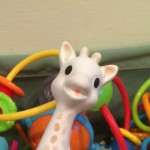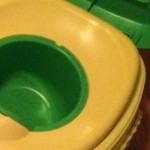We’ve been spending a lot of money and time on toy cleaning over at our house.
In addition to throwing a toy or two in the dishwasher every few months, at least a couple of times a week we wipe down the toys my daughter has recently played with using expensive Seventh Generation disinfecting wipes or cheaper Clorox alternatives. The cost of these wipes, however, is starting to add up and I’m embarrassed to admit that we’re easily shelling out a couple hundred dollars annually on baby and toddler toy cleaning.
So to trim our expenses and cut down on the effort involved, I set out researching toy cleaning, and I turned to Dr. Karen Sokal-Gutierrez, a professor and children’s health expert at the University of California, Berkeley School of Public Health. Just in time for the spring cleaning season, the time- and money-saving trick I learned from Dr. Sokal-Gutierrez is today’s hint.
The trick: Every time you do a load of dishes or a load of laundry, throw in some toys.
The dishwasher is a great way to clean and sanitize plastic toys without batteries (just make sure not to put squeaky rubber toys like Sophie the Giraffe in there), while the laundry machine can clean stuffed animals and other fabric toys.
If you like the idea of turning dishwashing and laundry time into toy washing time, you could keep track of which toys you’ve cleaned when with a checklist, say a post-it on the dishwasher or washing machine, using an approach similar to one I covered for keeping track of medicine doses.
You may still be wondering, however, how often you should wash each toy this way, and how often you should hand wash toys that can’t go in the dishwasher or laundry machine with warm water, soap and a disinfecting wipe or a diluted bleach solution.
Dr. Sokal-Gutierrez wrote on the Web site of toy company Fisher-Price that it’s a good idea to clean toys when they’re noticeably dirty, when your little one is getting over being sick and after a play date.
Other than that, as she told me, there’s no magic formula on how often toys need to be cleaned, though the more frequently they are cleaned, the better. One idea, shared on the Fisher-Price site, is to consider washing each toy on a regular schedule, say weekly or monthly.
If it’s generally your own child playing with the toys and your child is healthy, there’s not such a concern about germs, Dr. Sokal-Gutierrez says. So the important thing is that “you don’t want to make yourself crazy” by going overboard with toy cleaning,” she says.
In fact, Dr. Sokal-Gutierrez says that according to a theory called the “Hygiene Hypothesis,” living in too hygienic of an environment fails to stimulate a child’s immune system to fight the normal microbes in the environment, making the immune system more likely to react to things it shouldn’t and leading to higher rates of allergies and autoimmune diseases. “So don’t feel guilty about having your child exposed to germs – they could be healthy, to some extent,” Dr. Sokal-Gutierrez says.
That exposure to at least some germs may actually be a good thing is something many moms who don’t clean toys that often point out.
So, until someone tells me otherwise, I’m going to stop using so many disinfectant wipes and instead, we’re going to increase the efficiency of our dishwasher and laundry loads. For more on cleaning and sanitizing toys (there is a difference), check out these toy cleaning guidelines for early care programs that the American Academy of Pediatrics directed me toward.
What are your tips for washing toys, and what questions do you have about the subject?
Follow Hint Mama on Facebook and Twitter, and read more about her and her disclosures.







[…] that vein, and just in time for spring cleaning, stay tuned for a follow-up post on tips for getting rid of toys. As my friend says when he’s […]